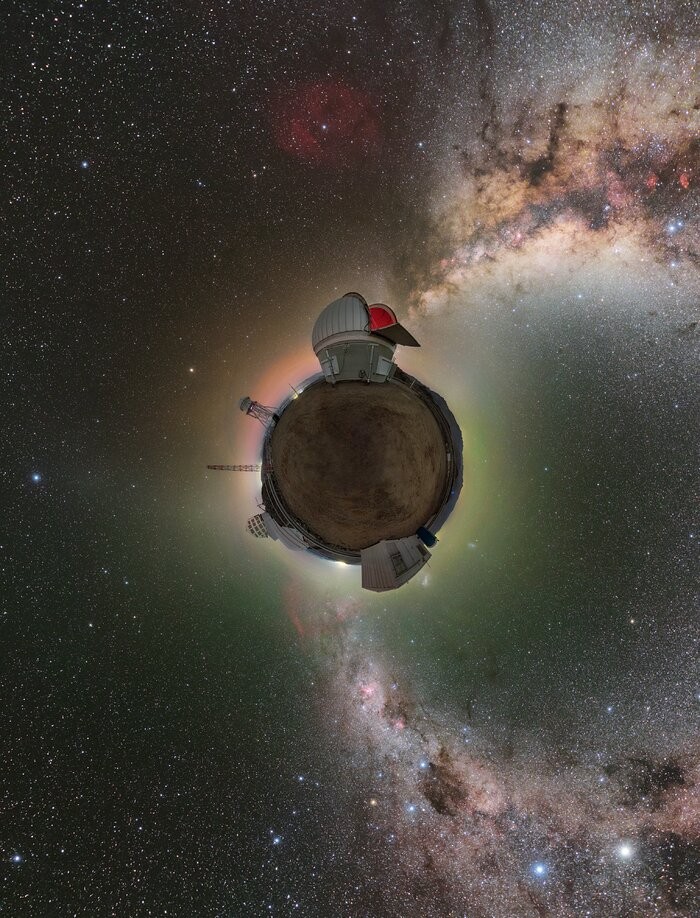On January 10, NOIRLab shared a space photo featuring a captivating view of what seems to be a little rocky planet. The mind-bending 360-degree image of the Vera C. Rubin Observatory became the lab's photo that week, appearing like a unique celestial body in this surreal photograph.

The Rubin Auxiliary Telescope (AuxTel), with its open dome and deep red interior, resembles a rocky planet amid the Milky Way at Cerro Pachón in Chile.
A Little Rocky World
The captivating image captured in April 2022 at Cerro Pachón mountain in northern Chile shows the Rubin Auxiliary Telescope, Vera C. Rubin Observatory, and the Milky Way creating a stunning celestial scene. Originally a 360-degree panoramic photo, the image is transformed into a photosphere, making Cerro Pachón's peak resemble its own unique planet.
The Rubin Auxiliary Telescope's main dome, known as AuxTel, with its red-lit interior, appears like a rocky celestial body with the Milky Way stars seemingly pouring out from it. Surrounding the "planet," the atmospheric phenomenon of airglow produces mesmerizing green and red lights caused by ionized trace particles and gases.
In the lower left of the image, the Vera C. Rubin Observatory stands out as a geometric dome, symbolizing a revolutionary shift in astronomy.
Meanwhile, the Rubin Auxiliary Telescope, portrayed against the backdrop of the expansive Milky Way, appears as if it occupies its own planetary realm. The surreal view showcases airglow, dark dust trails, and red star-forming regions intertwined throughout the galaxy.
The image, available in various formats, is the creation of Petr Horálek, an astrophotographer from the Czech Republic and a NOIRLab audiovisual ambassador participating in the NOIRLab 2022 Photo Expedition.
Petr Horálek, using a Canon Ra camera with a Sigma 35mm lens, captured a series of 10-second exposures, which he skillfully stitched into a panorama. Expressing the profound experience of being amidst the awe-inspiring night sky at Cerro Pachón, Horálek emphasized the historical significance of photographing the Rubin Observatory, anticipating its role as a premier survey telescope for years to come in the field of astronomy.
READ ALSO: NASA's Image of the Week Features the 'Cat Loaf Rock' on Mars Captured by the Perseverance Rover
Rubin Observatory Set To Revolutionize Astronomy
The distant Vera C. Rubin Observatory, part of a joint initiative by the National Science Foundation and the US Department of Energy, promises to revolutionize current understanding of the universe through its ambitious Legacy Survey of Space and Time (LSST), marking a new era in astronomical exploration.
Scheduled to begin operations in August, the observatory will conduct nightly surveys of the Southern Hemisphere's night sky using a Simonyi Survey Telescope and a record-breaking 3,200-megapixel camera. This observatory, positioned on the brink of changing the landscape of astronomy, is jointly operated by the National Science Foundation's NOIRLab and the US Department of Energy's SLAC National Accelerator Laboratory.
The Legacy Survey of Space and Time (LSST), a decade-long project by the observatory, will nightly scan the sky, generating 15 terabytes of data. This extensive survey aims to detect moving or brightening objects like asteroids and supernovas and holds the potential to unveil 20 billion galaxies and stars.
RELATED ARTICLE: Space Photo of the Week: NASA's Juno Spacecraft Captures Up Close Photo of Jupiter's Volcanic Moon Io at 7,260 Miles
Check out more news and information on Space in Science Times.














